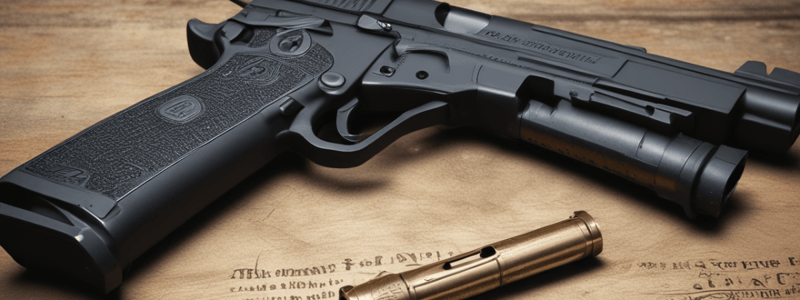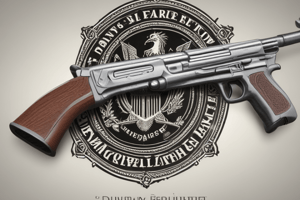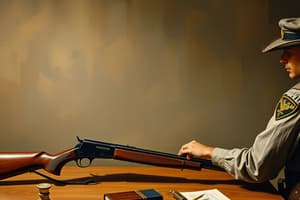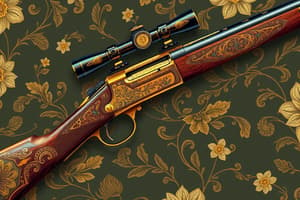Podcast
Questions and Answers
What type of license is required to manufacture firearms?
What type of license is required to manufacture firearms?
- Type 09
- Type 07 (correct)
- Type 08
- Type 10
Which type of license allows the importation of destructive devices?
Which type of license allows the importation of destructive devices?
- Type 11 (correct)
- Type 08
- Type 09
- Type 10
What is the purpose of firearms qualification inspections?
What is the purpose of firearms qualification inspections?
- To issue a Federal firearms license
- To determine the applicant's business premises
- To verify ownership and control
- All of the above (correct)
What is the minimum age requirement to obtain a Federal firearms license?
What is the minimum age requirement to obtain a Federal firearms license?
What is the purpose of ATF Form 7?
What is the purpose of ATF Form 7?
What is the goal of minimizing or eliminating the possibility of a firearms dealer being a prohibited person?
What is the goal of minimizing or eliminating the possibility of a firearms dealer being a prohibited person?
What is a requirement for obtaining a Federal firearms license?
What is a requirement for obtaining a Federal firearms license?
What is the purpose of reviewing the application and proposed operations with the applicant?
What is the purpose of reviewing the application and proposed operations with the applicant?
What is the goal of ensuring the integrity of the records system?
What is the goal of ensuring the integrity of the records system?
What is the purpose of the preliminary steps in firearms qualification inspections?
What is the purpose of the preliminary steps in firearms qualification inspections?
What type of FFL does not deal in firearms of any type?
What type of FFL does not deal in firearms of any type?
What is required for ammunition manufacturers in terms of record keeping?
What is required for ammunition manufacturers in terms of record keeping?
What is the purpose of ATF Form 5300.11?
What is the purpose of ATF Form 5300.11?
What type of FFL requires a separate record of armor piercing ammunition dispositions?
What type of FFL requires a separate record of armor piercing ammunition dispositions?
What is the purpose of ATF Form 6?
What is the purpose of ATF Form 6?
What is the purpose of ATF Form 6A?
What is the purpose of ATF Form 6A?
What type of FFL is required to consolidate their records of importation or other acquisition of firearms?
What type of FFL is required to consolidate their records of importation or other acquisition of firearms?
What is the purpose of ATF Form 3311.4?
What is the purpose of ATF Form 3311.4?
What is the purpose of TTB Form 5300.26?
What is the purpose of TTB Form 5300.26?
What type of FFL requires a separate record of armor piercing ammunition dispositions to government entities?
What type of FFL requires a separate record of armor piercing ammunition dispositions to government entities?
What is the primary goal of the Industry Operations Investigator's qualification inspections?
What is the primary goal of the Industry Operations Investigator's qualification inspections?
What is the purpose of the acknowledgement form?
What is the purpose of the acknowledgement form?
What is the purpose of ATF Form 4587?
What is the purpose of ATF Form 4587?
What type of license is required for a Pawnbroker?
What type of license is required for a Pawnbroker?
What is the primary purpose of the Industry Operations Manual, ATF O 5000.19?
What is the primary purpose of the Industry Operations Manual, ATF O 5000.19?
What is the purpose of the National Instant Check System (NICS)?
What is the purpose of the National Instant Check System (NICS)?
What is the primary focus of the Industry Operations Investigator's inspections?
What is the primary focus of the Industry Operations Investigator's inspections?
What is the goal of the Industry Operations Investigator's assistance to the industry member?
What is the goal of the Industry Operations Investigator's assistance to the industry member?
What form is used to report multiple sales or other dispositions of pistols and revolvers?
What form is used to report multiple sales or other dispositions of pistols and revolvers?
What type of license is required for a Manufacturer of Ammunition for Firearms Other Than Ammunition for Destructive Devices or Armor Piercing Ammunition?
What type of license is required for a Manufacturer of Ammunition for Firearms Other Than Ammunition for Destructive Devices or Armor Piercing Ammunition?
What is the purpose of the Acquisition and Disposition records (Bound Book)?
What is the purpose of the Acquisition and Disposition records (Bound Book)?
What is the requirement for sending ATF Form 3310.4?
What is the requirement for sending ATF Form 3310.4?
What is the purpose of the Industry Operations Investigator's 4473 reviews and checking A&D?
What is the purpose of the Industry Operations Investigator's 4473 reviews and checking A&D?
What type of questions or concerns should be referred to the Alcohol and Tobacco Tax and Trade Bureau (TTB)?
What type of questions or concerns should be referred to the Alcohol and Tobacco Tax and Trade Bureau (TTB)?
What is the purpose of the ATF Form 4473?
What is the purpose of the ATF Form 4473?
What is the requirement for Collector of Curios and Relics (C&R) Type 03 FFL?
What is the requirement for Collector of Curios and Relics (C&R) Type 03 FFL?
What is the purpose of the ATF right of entry?
What is the purpose of the ATF right of entry?
What is the requirement for Firearms transfers to non-immigrant aliens?
What is the requirement for Firearms transfers to non-immigrant aliens?
What is the purpose of ATF Form 5320.1?
What is the purpose of ATF Form 5320.1?
What is the purpose of firearms inspections?
What is the purpose of firearms inspections?
What is required to be kept in chronological order?
What is required to be kept in chronological order?
What is the purpose of ATF Form 5320.3?
What is the purpose of ATF Form 5320.3?
What is reviewed during preliminary procedures of firearms inspections?
What is reviewed during preliminary procedures of firearms inspections?
What is the purpose of ATF Form 5320.20?
What is the purpose of ATF Form 5320.20?
What is verified during preliminary procedures of firearms inspections?
What is verified during preliminary procedures of firearms inspections?
What is the purpose of ATF Form 5320.4?
What is the purpose of ATF Form 5320.4?
What is looked for during firearms inspections?
What is looked for during firearms inspections?
What is reviewed during preliminary procedures of firearms inspections?
What is reviewed during preliminary procedures of firearms inspections?
Why do Industry Operations Investigators handle firearms during an inventory?
Why do Industry Operations Investigators handle firearms during an inventory?
What is the first safety rule when handling firearms?
What is the first safety rule when handling firearms?
Why is it important to remove rings and other jewelry when handling firearms?
Why is it important to remove rings and other jewelry when handling firearms?
What should an Industry Operations Investigator do when closing the action of a firearm?
What should an Industry Operations Investigator do when closing the action of a firearm?
What is the purpose of conducting a complete physical inventory?
What is the purpose of conducting a complete physical inventory?
Why is it important to inspect the action and chamber of a firearm?
Why is it important to inspect the action and chamber of a firearm?
What should an Industry Operations Investigator do before passing a firearm to someone else?
What should an Industry Operations Investigator do before passing a firearm to someone else?
Why is it important to be aware that accidents can happen when handling firearms?
Why is it important to be aware that accidents can happen when handling firearms?
What should IOIs review in addition to the compliance history?
What should IOIs review in addition to the compliance history?
What is the purpose of contacting ATF Criminal Enforcement and/or querying Spartan?
What is the purpose of contacting ATF Criminal Enforcement and/or querying Spartan?
When is advance notification of inspection generally given?
When is advance notification of inspection generally given?
What should IOIs do during the opening inspection procedures?
What should IOIs do during the opening inspection procedures?
What should IOIs review to ensure compliance with the licensee's business operations?
What should IOIs review to ensure compliance with the licensee's business operations?
What should IOIs do if there are material changes affecting the licensee's status?
What should IOIs do if there are material changes affecting the licensee's status?
What is a Privately Made Firearm (PMF)?
What is a Privately Made Firearm (PMF)?
What should a licensee do when taking a PMF into inventory?
What should a licensee do when taking a PMF into inventory?
What should IOIs examine in the Acquisition and Disposition (A&D) Record?
What should IOIs examine in the Acquisition and Disposition (A&D) Record?
What is the purpose of reviewing the approved variances?
What is the purpose of reviewing the approved variances?
Study Notes
Industry Operations Investigator's Role
- Conduct qualification inspections to verify the accuracy of the application and determine the applicant's ability to comply with ATF requirements
- Ensure firearms industry members are not prohibited from engaging in licensed business operations
- Assist the industry member in understanding Federal laws and regulations
- Conduct inspections to determine compliance with Federal firearm laws and regulations
- Pursue and recommend adverse action, such as a warning conference and warning letter
- Assist the industry member in achieving compliance with Federal laws and regulations
- Identify patterns of illegal firearms transactions
- Refer tax liability related questions or concerns to the Alcohol and Tobacco Tax and Trade Bureau (TTB)
Types of Federal Firearms Licenses (FFL)
- Dealer (01): includes Pawnbroker (02) and Gunsmith activities
- Collector of Curios and Relics (Type 03)
- Manufacturer of Ammunition for Firearms Other Than Destructive Devices or Armor Piercing Ammunition (Type 06)
- Manufacturer of Firearms Other Than Destructive Devices (Type 07)
- Importer of Firearms Other Than Destructive Devices or Ammunition for Firearms Other Than Destructive Devices, or Ammunition Other Than Armor Piercing Ammunition (Type 08)
- Dealer in Destructive Devices (Type 09)
- Manufacturer of Destructive Devices, Ammunition for Destructive Devices or Armor Piercing Ammunition (Type 10)
- Importer of Destructive Devices, Ammunition for Destructive Devices or Armor Piercing Ammunition (Type 11)
Firearms Qualification Inspections
- Conducted to determine whether the proposed business activity requires an FFL and whether the application is for the proper type of license
- Verify the applicant's ability to comply with state and local laws
- Identify ownership and control
- Inform applicants of the laws and regulations governing their activities
- Minimize or eliminate the possibility of a firearms dealer being a prohibited person
- Reduce illegal diversion and ensure the integrity of the records system
General Steps for Firearms Qualification Inspections
- Review ATF Form 7 (5310.12) and supporting documents
- Make an appointment with the applicant
- Verify the applicant's identity and record that information
- Examine available business documents
- Verify ownership and/or control and identify responsible persons
- Educate the licensee by explaining record keeping and reporting requirements
Closing Actions
- Advise the applicant of your recommendation
- Advise the applicant of renewal procedures
- Advise the applicant of how to obtain ATF forms
- Have the applicant sign an Acknowledgment of the Federal Firearms Regulations
Collector of Curios and Relics (Type 03 FFL)
- Required to keep bound book records
- Does not execute ATF Forms 4473, nor do they conduct NICS criminal background checks
Manufacturer (Ammunition), Type 06 FFL
- No formal record-keeping requirements
- Required to maintain commercial records sufficient to substantiate the tax return### Privately Made Firearms (PMFs)
- A PMF is a firearm made by a non-licensee without a serial number.
- If a licensed dealer, manufacturer, or importer receives a PMF, they must record it as an acquisition in their Acquisition and Disposition (A&D) records.
- The licensee must mark the PMF with a unique serial number starting with their FFL's abbreviated license number (first three and last five digits) followed by a hyphen and a unique identification number.
Marking and Recording PMFs
- The markings must be completed within seven days of receipt or before disposition, whichever is sooner.
- A licensee can take a PMF off-premises for marking purposes to another licensee or non-licensee, but only under direct supervision.
Examine Acquisition and Disposition (A&D) Records
- Examine A&D records for:
- Format
- Timely entries
- Completeness
- Accuracy
Physical Inventory and Safe Handling
- Industry Operations Investigators handle firearms during:
- Inventory
- Checking markings and serial numbers
- Measuring for barrel or overall length for NFA compliance
- Examination for NFA conversion
- Safety rules:
- Treat every firearm as if it's loaded
- Keep muzzle pointed in a safe direction
- Keep fingers off the trigger and away from the trigger guard
- Determine if the weapon is loaded before handling
- Remove the source of ammunition and open the action
- Inspect the action and chamber
- Additional safety guidelines:
- Never pretend to have more knowledge than you do
- Never rely on mechanical safety or someone else checking the firearm
Etiquette and Handling
- Always ask to handle firearms, as they are private property
- Remove rings and jewelry that could scratch firearms
- Ensure hands are clean before handling firearms
- Wipe metal parts after handling each firearm
- Avoid dry-firing or repeatedly working the action of any firearm, especially collectible ones
- Close the action of any firearm gently
Conducting Physical Inventory
- A complete physical inventory allows the Industry Operations Investigator to:
- Determine the accuracy of the licensee's records
- Examine inventory for illegal firearms (unregistered NFA weapons, obliterated serial numbers, illegal conversions, etc.)
- Verify proper marking of firearms
- Identify problems, such as storage of business inventory with personal (unmarked) firearms
- Industry Operations Investigators (IOIs) must conduct full inventory verification, regardless of the number of firearms in the licensee's inventory.
Studying That Suits You
Use AI to generate personalized quizzes and flashcards to suit your learning preferences.
Description
This quiz covers the role of an Industry Operations Investigator in regulating the firearms industry, including conducting qualification inspections and ensuring compliance with ATF requirements and state and local laws.




